Table of Contents
If you are aiming to crack SBI PO 2025, then gear up because the SBI PO Notification 2025 has been officially released! As you know, the Preliminary Exam primarily consists of three sections, with Reasoning Ability especially the Seating Arrangement section playing a crucial role in your success. To enhance your preparation, we have compiled a set of Seating Arrangement questions for SBI PO Exam, along with detailed solutions. Start practicing now and boost your chances of selection.
Seating Arrangement Questions for SBI PO Exam
The Seating Arrangement and Puzzle section in the Reasoning Ability segment is a crucial part of the SBI PO Exam 2025, offering candidates a significant opportunity to boost their overall score. Typically, this section features around 8 to 10 questions on Seating Arrangement, making it essential to master for success. Consistent practice with various types of arrangements, including linear, circular, and advanced seating patterns, can significantly enhance both speed and accuracy, ultimately improving exam performance.
Directions (1-5): Study the following information carefully and answer the questions given below.
Eight friends A, B, C, D, E, F, G and H are sitting in a row on chairs numbered 23 to 30 in ascending order from left to right and all of them are facing south. C sits on the chair no. 24. There are four persons between C and A. B and H sit adjacent to each other. G sits adjacent to neither A nor C. E never sits on an odd-numbered chair. Neither B nor G sits on chair number 26. There is only one person between F and B. D sits left of E.
Q1. Who amongst the following sits to the immediate left of E?
(a) F
(b) C
(c) A
(d) B
(e) None of these
Q2. Which of the following pairs sits at extreme ends of the row?
(a) D, C
(b) H, D
(c) G, H
(d) B, A
(e) None of these
Q3. How many persons are there between A and B?
(a) One
(b) None
(c) Two
(d) Three
(e) None of these
Q4. Four of the following five are alike in a certain way and hence from a group. Who is the one that does not belong to that group?
(a) G
(b) B
(c) F
(d) H
(e) A
Q5. Who among the following person sits on chair no. 25?
(a) H
(b) E
(c) A
(d) D
(e) None of these
Directions (6-10): Study the following data carefully and answer the questions accordingly.
Seven people are sitting around a circular table. Four of them face outside. M and L face the opposite direction of F. R sits third to the right of K. L sits immediate right of F. At least one person sits between P and K. M sits third to the right of P who is facing inside. Two people sit between K and F who is not a neighbor of M and P. R sits second to the right of H.
Q6. Who sits three places away from H?
(a) The one who sits third to the right of P
(b) M
(c) P
(d) The one who sits second to the left of K
(e) None
Q7. Who among the following are the neighbors of K?
(a) R and the one who sits immediate left of L
(b) L, M
(c) M, and the one who sits second to the left of R
(d) H, P
(e) None of these
Q8. Who sits fourth to the left of M?
(a) H
(b) The one who sits immediate left of F
(c) L
(d) The one who sits third to the right of H
(e) None of these
Q9. Find the correct statement/statements from the following.
- R and P face the opposite direction.
- P sits second to the right of K.
III. The neighbors of F face the opposite direction.
(a) Only 1
(b) Both 1 and 3
(c) Both 2 and 3
(d) Only 3
(e) All are correct
Q10. Find the odd one.
(a) F
(b) H
(c) K
(d) R
(e) M
Directions (11-15): Read the following information carefully and answer the following questions.
Ten people sit in a two-parallel row. Five people sit in each row. In row-1 A, B, C, D and E seated and all face towards south. In row-2 L, M, N, O and P seated and all face towards north. D sits second to the left of B. N sits third to the left of M. O does not sit at the end. People seated in row-1 face people seated in row-2. A sits third to the right of C. P sits second to the right of the one who faces A. B faces the one who sits second to the left of L.
Q11. How many persons sit to the left of B?
(a) Two
(b) One
(c) None
(d) Three
(e) Four
Q12. If A is related to O and B is related to M, then in the same way C is related to _?
(a) N
(b) O
(c) L
(d) M
(e) P
Q13. Who amongst the following sits third to the right of the one who faces A?
(a) M
(b) L
(c) P
(d) O
(e) None of these
Q14. Who sits exactly between E and C?
(a) A
(b) B
(c) Cannot be determined
(d) D
(e) None
Q15. Four of the following five are alike in a certain way and hence form a group. Which of the following does not belong to that group?
(a) A
(b) N
(c) L
(d) D
(e) P
Directions (16-20): Study the following information carefully and answer the question given below.
Eight persons are sitting in a straight line and all are facing north direction. Each of them prepares for different competitive exam. S prepares for Bank and sits third to the right of Q. R sits immediate left of V who prepares for SSC. The one who prepares for AFCAT sits second to the left of Q. The one who prepares for UPSC sits third to the left of V. W prepares for NDA and he is an immediate neighbour of U who does not prepare for AFCAT. V is not an immediate neighbour of S. Persons who prepare for CDS and UPSC sit together. T sits third to the left of the one who prepares for UGC NET. W is not an immediate neighbour of S. P does not prepare for CTET.
Q16. Who among the following person prepare for CTET exam?
(a) T
(b) R
(c) W
(d) U
(e) None of these
Q17. Who among the following person sits third to the right V?
(a) The one who prepares for AFCAT
(b) The one who prepares for CTET
(c) S
(d) P
(e) None of these
Q18. What is the position of Q with respect to T?
(a) Third to the right
(b) Immediate Left
(c) Second to the right
(d) Immediate Right
(e) None of these
Q19. Which of the following statement is not true about U?
(a) U prepares for CTET
(b) U sits immediate right of S
(c) U does not prepare for UPSC
(d) Only two persons sit between U and the one who prepares for SSC
(e) Both (b) and (d)
Q20. Who among the following sits immediate right of the one who prepares for UGC NET?
(a) V
(b) U
(c) W
(d) P
(e) None of these
Directions (21-25): Study the following information carefully and answer the questions given below:
Eight Cricketers are sitting around a circular table facing the centre. Each of them is belongs different country. F is sitting second to the left of A. The one who is belongs Australia is an immediate neighbour of A. There are only three people sitting between the one who is belongs to Australia and E. Only one person sits between the one who is belongs to England and E. The one who is belongs to South Africa is to the immediate right of the one who is belongs to England. B is second to the right of A. H belongs to Australia. G and C are immediate neighbours of each other. Neither G nor C belongs to England. The one who is belongs to Pakistan is immediate left of F. The one who is belongs to West Indies is second to the right of the one who is belongs to South Africa. The one who is belongs to India is an immediate neighbour of the one who is belongs to England. G is second to the right of the one who is belongs to Bangladesh. D sits third to the right of the one who belongs to Sri Lanka.
Q21. Who among the following sits second to the left of the one who belongs to West Indies?
(a) B
(b) A
(c) F
(d) D
(e) C
Q22. Who among the following belongs to Pakistan?
(a) D
(b) A
(c) G
(d) E
(e) F
Q23. Which of the following statement is true about A?
(a) F sits third right of A
(b) A belongs to South Africa
(c) Only two persons sit between A and F
(d) A belongs to India
(e) A sits immediate left of G
Q24. What is the position of C with respect to H?
(a) Immediate left
(b) Second to the right
(c) Third to the left
(d) Fourth to the right
(e) None of these
Q25. Who among the following facing the one who belongs to Bangladesh?
(a) B
(b) H
(c) G
(d) F
(e) C
Solutions
Solutions (1-5):

S1. Ans.(c)
S2. Ans.(e)
S3. Ans.(d)
S4. Ans.(d)
S5. Ans.(e)
Solutions (6-10):
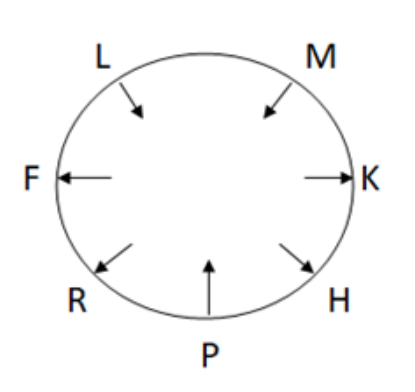
S6. Ans.(d)
S7. Ans.(c)
S8. Ans.(b)
S9. Ans.(e)
S10. Ans.(e)
Solutions (11-15):
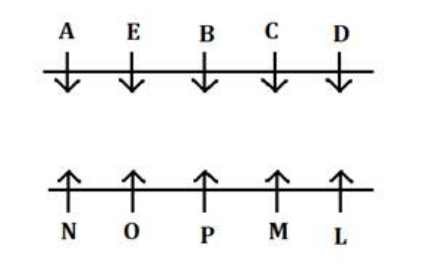
S11. Ans.(a)
S12. Ans.(c)
S13. Ans.(a)
S14. Ans.(b)
S15. Ans.(e)
Solutions (16-20):

S16. Ans.(d)
S17. Ans.(b)
S18. Ans.(a)
S19. Ans.(b)
S20. Ans.(c)
Solutions (21-25):
Sol. 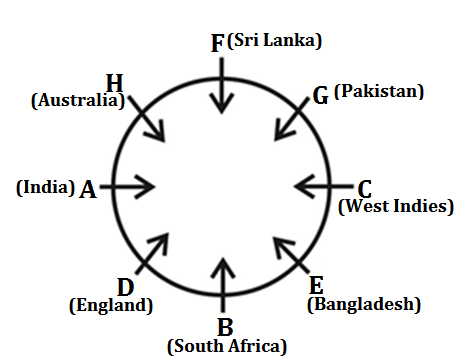
S21.Ans(a)
S22.Ans(c)
S23.Ans(d)
S24.Ans(c)
S25.Ans(b)
SBI PO: Seating Arrangement & Puzzle Questions Asked in Last 3 Years
Seating arrangement and puzzle questions play a crucial role in the reasoning section of the SBI PO exam, often determining a candidate’s overall score. Over the last three years, questions have included linear and circular seating, box-based arrangements, floor-based puzzles, and scheduling problems. These questions vary in complexity, requiring strong logical reasoning and analytical skills. Practising past year’s seating arrangement and puzzle questions can help candidates understand the difficulty level and improve their problem-solving speed for the upcoming exam.
Directions (01-05): Read the given information carefully and answer the questions based on it:
Six persons visit a place on two dates 11 and 22 in three different months i.e., September, October and November. They all like different colors viz. white, blue, pink, green, red and yellow but not necessarily in the same order as given. The one who likes yellow visits three persons after L. L and S visit on same date and in the month of even numbered days. Two persons visit between S and R who likes green. Number of persons visit before R is same as the number of persons visit after V. The one who likeswhite visit just beforeH. No one visit between K and the one who likes blue. The one who likes red visits before the one who likes pink.
Q01. How many persons visit between K and H?
(a) None
(b) One
(c) Two
(d) Three
(e) Four
Q02. Which of the following colors does S like?
(a) Red
(b) Blue
(c) Pink
(d) White
(e) Yellow
Q03. Who among the following visit on 22 October?
(a) V
(b) H
(c) K
(d) S
(e) L
Q04. The one who likes blue, visit on which of the following date?
(a) 22 October
(b) 11 November
(c) 11 October
(d) 22 November
(e) 22 September
Q05. Which of the following statement(s) is/are true?
I. The one who likes green is the last one to visit
II. H likes pink
III. More than two persons visit before V
(a) Only II
(b) Only I and III
(c) Only I and II
(d) Only III
(e) All I, II, III are true
Directions (06-10): Read the given information carefully and answer the questions based on it:
Eight persons sit in a row. Four persons face north and rest face south. Three persons sit between A and B and one of them sits at the end of the row. C sits second to the right of B who faces north. D and B face same direction but they do not sit adjacent to each other. E sits third to the left of D and faces opposite direction to D. G sits third to the right of C. Both the immediate neighbors of G face same direction. H sits to the right of F.
Q06. What is the position of F with respect to E?
(a) Second to the right
(b) Second to the left
(c) Fourth to the left
(d) Third to the right
(e) Immediate left
Q07. Who among the following sits just right of B?
(a) H
(b) E
(c) D
(d) F
(e) G
Q08. How many persons sit to the left of G?
(a) One
(b) None
(c) Three
(d) Five
(e) Two
Q09. Which of the following pair is dissimilar to other four pairs?
(a) C-E
(b) A-G
(c) D-F
(d) B-H
(e) G-C
Q10. If all the persons rearrange their seating positions and now, they sit in alphabetical order from left end of the row (Direction of all persons remain the same), then how many persons will remain on their positions?
(a) None
(b) One
(c) Two
(d) Three
(e) More than three
Directions (11-15): Study the following information carefully and answer the questions given below
Six persons A, B, C, D, E and F sit around a circular table facing the centre but not necessarily in the same order. They like different flowers viz. Rose, Daisy, Lily, Jasmine, Marigold and Dahila but not necessarily in the same order.
F sits 2nd to the left of the one who likes Rose. B and the one who likes Rose are immediate neighbours. A faces the one who likes Jasmine and sits near F. C sits 2nd to the left of the one who likes Lily. The one who likes Dahila sits just right of the one who likes Daisy. C and D are not an immediate neighbour.
Q11. Who sits immediate right of the person who likes Marigold?
(a) F
(b) B
(c) C
(d) D
(e) E
Q12. Which flower does F like?
(a) Jasmine
(b) Dahila
(c) Lily
(d) Marigold
(e) None of these
Q13. Which of the following is true?
I. D and F are not an immediate neighbour
II. A likes Lily
III. D does not like Rose
(a) Both I and III
(b) Only II
(c) Both I and II
(d) Only III
(e) Only I
Q14. Four of the following five are alike in a certain way and hence form a group. Which of the following does not belong to that group?
(a) D- Rose
(b) F- Daisy
(c) A- Lily
(d) E- Jasmine
(e) B- Marigold
Q15. Who is sitting just right of the person who likes Dahila?
(a) A
(b) B
(c) C
(d) D
(e) F
Directions (16-20): Study the following information carefully and answer the questions given below
Ten persons P to Y live in 10 storey building but not necessarily in the same order. The bottommost floor is numbered as 1 and so on till the topmost floor is numbered as 10. V lives on prime numbered floor but below 4th floor. S lives below V but not on the ground floor. There are as many persons live above S as below P. More than three persons live between P and Y who lives above X. One person lives between T and Y. W lives just below R. U does not live below Q.
Q16. On which floor does T live?
(a) 2nd floor
(b) 3rd floor
(c) 4th floor
(d) 5th floor
(e) 6th floor
Q17. Who lives on the topmost floor?
(a) V
(b) T
(c) U
(d) W
(e) Y
Q18. How many persons live between W and S?
(a) Four
(b) Two
(c) Three
(d) Six
(e) Five
Q19. The numbers of persons live between R and Y is half than the numbers of persons live below _____________.
(a) Q
(b) U
(c) W
(d) X
(e) None of these
Q20. Four of the following five are alike in a certain way and hence form a group. Which of the following does not belong to that group?
(a) V
(b) T
(c) S
(d) W
(e) Q
Direction (21-25): Study the following information and answer the questions below:
Eight persons A, B, C, D, E, G, H and K sit in a linear row and face north (but not necessarily in the same order). All the persons work in a company on different designations viz. MD, CMD, CEO, Senior executive, Executive, Manager, Associate Manager and HR.
Two persons sit between B and the one who is CEO. G who is HR sits third to the right of CEO. K is one of the immediate neighbours of HR. The one who is Executive sits exactly between K and the one who is CEO. D sits third to the left of the one who is Executive. D sits adjacent to A who is not CEO. Same number of persons sit to the left of A and right of the one who is Manager. C and the one who is Senior executive are immediate neighbours. Three persons sit between H and the one who is MD. D is not Associate Manager.
Q21. Who among the following is Associate Manager?
(a) B
(b) E
(c) K
(d) H
(e) None of these
Q22. Who among the following sits to the immediate right of G?
(a) A
(b) D
(c) E
(d) K
(e) None of these
Q23. How many persons sit between the one who is CMD and K?
(a) Three
(b) Four
(c) Five
(d) Two
(e) None of these
Q24. D works on which among the following designation?
(a) Manager
(b) CEO
(c) MD
(d) CMD
(e) None of these
Q25. What is the position of A with respect to the one who is CEO?
(a) Second to the left
(b) Immediate left
(c) Immediate right
(d) Third to the right
(e) None of these
Direction (26-28): Study the following information and answer the questions below:
Six persons P, Q, R, S, T and V sit around a circular table but not necessarily in the same order. Three of them face inside while rest three faces outside the centre. They are of different ages (in years) viz. 15, 16, 18, 21, 25 and 27 but not in the same order as given.
V and R sits immediate left to each other. R’s age is perfect square number. Difference between the age of R and S is 2 years. S sits third to the right of R. P and T are immediate neighbours. The ages of both P and T are an even number. The age of Q is a multiple of five and sits second to the left to P. The persons whose age are a perfect square are immediate neighbours. T and Q faces each other.
Q26. Who among the following sits second to the right of T?
(a) The one who sits immediate right of V
(b) The one who sits second to the right of Q
(c) The one whose age is 27 years
(d) V
(e) None of these
Q27. What is the age of R?
(a) 16 years
(b) 15 years
(c) 27 years
(d) 25 years
(e) None of these
Q28. Who among the following is 21 years old?
(a) The one who faces R
(b) S
(c) The one who sits immediate left of R
(d) Either (b) or (c)
(e) None of these
Directions (29-30): Study the information carefully and answer the questions given below.
Six persons P, Q, R, S, T and U sit around a triangular table. Three persons sit at each corner of table and rest sit at middle of each side of table. All of them face inside and like different colours – Blue, Black, White, Violet, Red and Green. All the information is not necessarily in the same order. T sits 2nd to the left of the one who likes White, who sits opposite to U. R likes red. R is not an immediate neighbour of T and the one who likes white. Q sits 2nd to the left of P, who sits at one of the corners of the table. The one who likes Violet sits immediate left of the one who likes Black but not sit opposite to P. Q does not like Blue.
Q29. Who among the following sits 3rd to the left of S?
(a) The one who likes Violet
(b) T
(c) The one who sits immediate left of U
(d) U
(e) Both (a) and (d)
Q30. Which of the following pair is correct?
(a) P-White
(b) Q-Violet
(c) S-White
(d) T-Blue
(e) U-Green
Directions (31-35): Study the information carefully and answer the questions given below.
Ten Persons L, M, N, O, P, Q, R, S, T and U were born (but not necessarily in the same order) on either 9th or 30th of five different months- January, May, August, October and December.
Three persons were born between M and Q and they born on same date. Two persons were born between M and R, who was born in either May or December. The number of persons were born between R and Q is same as the number of persons were born between N and T. T was born in October. S was born just after L, who was born after R. P was born just before the month when O
was born. U was born before T. M was born after R. L and S were not born in the same month. U is not the eldest person.
Q31. How many persons were born between S and U?
(a) Three
(b) More than five
(c) Two
(d) Four
(e) None
Q32. Who among the following was born on 30th August?
(a) S
(b) P
(c) Q
(d) M
(e) L
Q33. The number of persons were born between N and S is same as the number of persons born after ___?
(a) P
(b) L
(c) S
(d) O
(e) None of these
Q34. Four of the following five are alike in a certain way and so form a group. Find the one who does not belong to that group?
(a) N
(b) L
(c) R
(d) O
(e) P
Q35. Who among the following was not born before October?
(a) U
(b) S
(c) R
(d) N
(e) O
Directions (36-40): Study the information carefully and answer the questions given below.
Six persons A, B, C, D, E and F live in a three-storey building such that ground floor is numbered as 1, above it is floor 2 then topmost floor is numbered as 3. Each of the floor has 2 flats in it as flat-1 and flat-2. Flat-1 of floor-2 is immediately above flat-1 of floor-1 and immediately below flat-1 of floor-3 and so on. In the same way flat-2 of floor-2 is immediately above flat-2 of floor-1 and immediately below flat-2 of floor-3 and so on. Flat1 is in west of flat-2. Each of them likes different fruits.
One floor gap between C and the one who likes Grapes in the same flat number. A lives on an even number floor in the north west of C. The one who likes apricot lives below A. The one who likes banana lives above C and in the south-east of D, who does not like Apple. F likes Apricot. D and A not like orange. E lives below B. One of the persons like coconut.
Q36. Who among the following likes Orange?
(a) B
(b) E
(c) C
(d) Either (a) or (c)
(e) None of these
Q37. Which of the following statement is true?
(a) A lives below F
(b) D likes Grapes
(c) E lives on an even number floor
(d) No one lives below B
(e) A and E lives on different floor
Q38. Who among the following lives in flat 2 on 3rd floor?
(a) D
(b) B
(c) E
(d) F
(e) C
Q39. Who among the following lives in the northeast of the one who likes Apricot?
(a) C
(b) D
(c) E
(d) B
(e) Both (c) and (d)
Q40. Who among the following lives just above the flat of A?
(a) F
(b) D
(c) E
(d) C
(e) B
Solution (01-05):

Solution (06-10):

Solution (11-15):
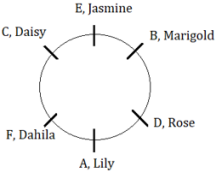
Solution (16-20):
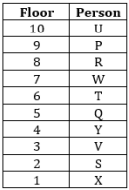
Solution (21-25):
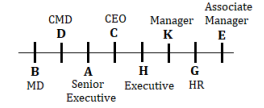
Solution (26-28):
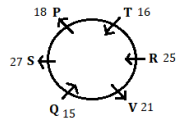
Solution (29-30):
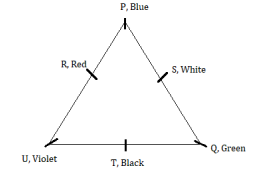
Solution (31-35):
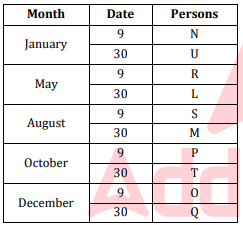
Solution (36-40):

| Related Posts | |
| SBI PO Cut-Off | SBI PO Notification |
| SBI PO Salary | SBI PO Preparation Strategy |
| SBI PO Exam Date | SBI PO Previous Year Question Papers |
| SBI PO Syllabus | SBI PO Exam Pattern |

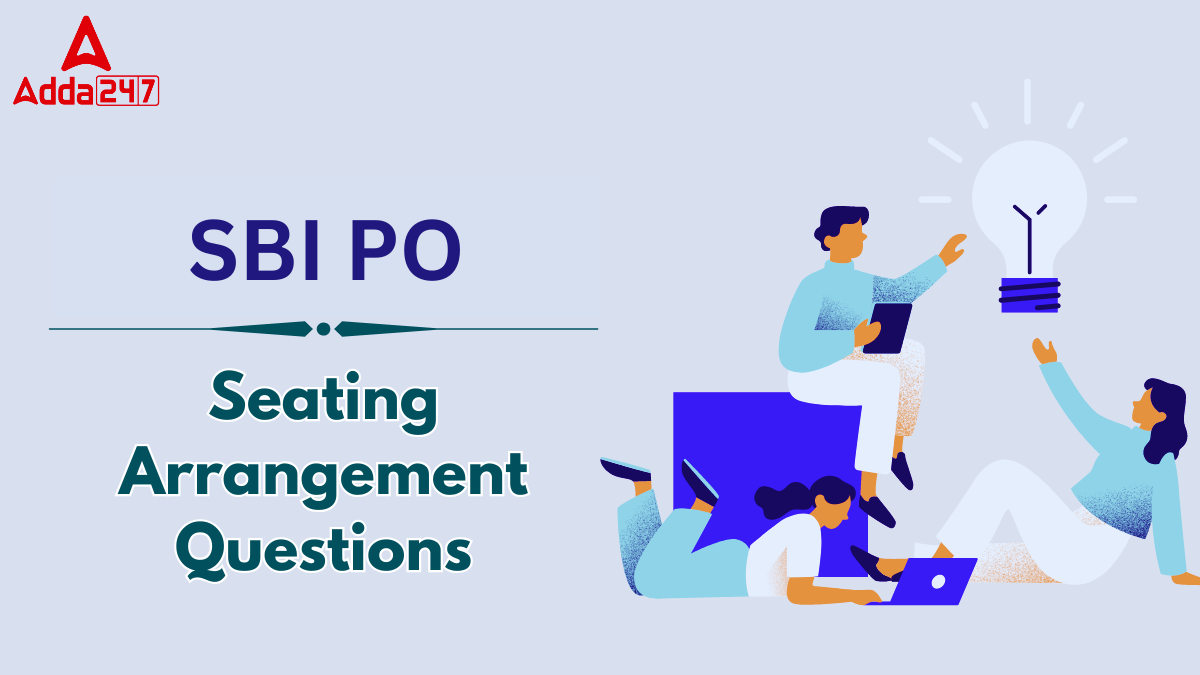


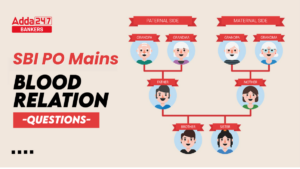 Important Blood Relation Questions for S...
Important Blood Relation Questions for S...
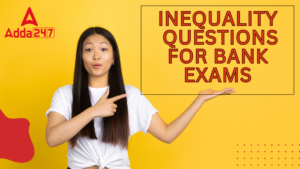 Inequality Questions for Bank Exams
Inequality Questions for Bank Exams
 SBI PO Reasoning Questions With Solution...
SBI PO Reasoning Questions With Solution...




